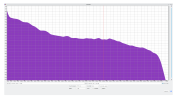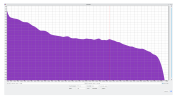Hi there,
i am playing around with DeltaWave since quite some time and bought a better ADC with features that are suitable for measuring and stuff like that and i noticed some strange behavior.
I am doing, for example, the following.
I am creating a sine sweep. 20Hz - 20kHz.
I record the Output from the DAC with my ADC and look at it, as flat as it gets. Perfect. The ADC is not perfect (it has ±0.1db) which causes everything above 30kHz to look like as it has a 0.1db push, but who cares.

The next Test --> I create an 96kHz/24bit White Noise (30 Seconds) and do the same test.
Again, it appears to be as flat as absolutely possible with the expected roll-off around 48kHz.

Now the strange thing, if i put the White Noise (Original) and the White Noise (Output of ADC), or a 30s piece of music, into Delta Wave, the result looks like this

When i compare those two files in Audacity, they look almost identical (They are not volume Matched so the scale is not perfect, but it is obvious, that there is no strong roll-off beyond 1kHz)


But when i export the matched files from DeltaWave, they look different (exactly how DeltaWave renders them)


That maybe an silly and obvious question, but can anyone explain me why DeltaWave shows this difference and if DeltaWave shows it, is it really there?
I would be surprised if my CS43131 has an roll-off after 1kHz that is >=1.5db at 20kHz (According to Cirrus Logic, it should be <±0.05db). So i assume what i see in Audacity is correct, there is no roll-off. Analyzing the CS43131 with other Software/Tools dedicated for analyzing, they also show a flat response up until 20kHz. So its not just Audacity
What is causing the effect that when i record an sweep, it looks perfectly flat, but when i compare it to the original sweep using DeltaWave, it suddenly has a >1db roll-off in the treble. Is this a timing issue? Is it caused by the ADC? Any help appreciated^^ eger to learn.
i am playing around with DeltaWave since quite some time and bought a better ADC with features that are suitable for measuring and stuff like that and i noticed some strange behavior.
I am doing, for example, the following.
I am creating a sine sweep. 20Hz - 20kHz.
I record the Output from the DAC with my ADC and look at it, as flat as it gets. Perfect. The ADC is not perfect (it has ±0.1db) which causes everything above 30kHz to look like as it has a 0.1db push, but who cares.

The next Test --> I create an 96kHz/24bit White Noise (30 Seconds) and do the same test.
Again, it appears to be as flat as absolutely possible with the expected roll-off around 48kHz.

Now the strange thing, if i put the White Noise (Original) and the White Noise (Output of ADC), or a 30s piece of music, into Delta Wave, the result looks like this

When i compare those two files in Audacity, they look almost identical (They are not volume Matched so the scale is not perfect, but it is obvious, that there is no strong roll-off beyond 1kHz)


But when i export the matched files from DeltaWave, they look different (exactly how DeltaWave renders them)


That maybe an silly and obvious question, but can anyone explain me why DeltaWave shows this difference and if DeltaWave shows it, is it really there?
I would be surprised if my CS43131 has an roll-off after 1kHz that is >=1.5db at 20kHz (According to Cirrus Logic, it should be <±0.05db). So i assume what i see in Audacity is correct, there is no roll-off. Analyzing the CS43131 with other Software/Tools dedicated for analyzing, they also show a flat response up until 20kHz. So its not just Audacity
What is causing the effect that when i record an sweep, it looks perfectly flat, but when i compare it to the original sweep using DeltaWave, it suddenly has a >1db roll-off in the treble. Is this a timing issue? Is it caused by the ADC? Any help appreciated^^ eger to learn.
Last edited:
